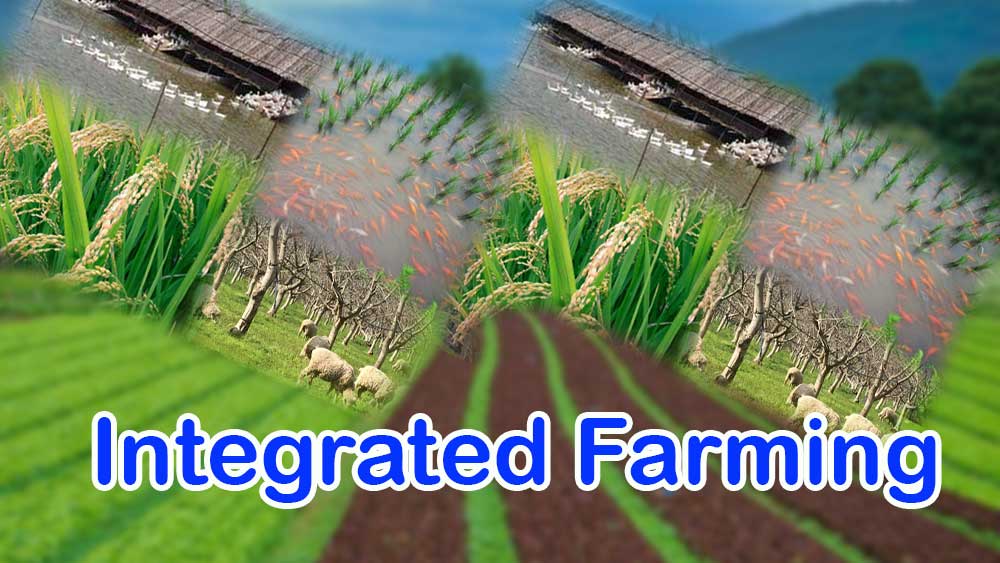Farming or agriculture offers you with different types of farming methods. There is a nice concept called integrated farming which allow us to have an incredible output you’re your small-scale farms. This concept definitely supports you to diversify your income.
When a farmer starts a cultivation, he has to bear high input cost. But sometimes he can’t earn much of money from his production. This mostly happens to small scale farmers. Integrated farming system is a good alternative for that problem. It can improve the feasibility of small-scale farms.
With the population growth, people trend to use high dosage of pesticides, weedicides like chemicals. As a result of this, whole world suffers from that. Integrate farming definitely helps you to be away from those unfavorable practices in your nice farm.
What is integrated farming?
In here there are many farming systems practicing in the same land area and each of these systems are interconnected with each other. Output of one enterprise will be an input to the other enterprise.
Integrated farming system has more integrated approaches than mono culture approaches. There are several integrated biosystems such as integrate crops and livestock and integrate fish and livestock. So, there are several systems of integrated farming. The waste of one system can be an input of another system. So, there are inter-related enterprise sets. This method reduces farmers input cost and increase production and income of the farmer.
Goals of Integrated Farming
Maximizing return from the unit area, reducing environmental pollution, maintaining soil status and fertility, increasing economic yield, improving the livelihood of the farming community, employment generation, solve the energy, fodder, fuel and timber crisis, provide balance nutritious foods for the farmers are the goals of this system.
Features of Integrated Farming
Integrated farming is an eco-friendly system. In here, not only crops there are several types of animals, fish, aquatic fauna and flora, birds, plants. This system improves the ecological diversity. There are several cropping methods. Mixed cropping, crop combination, crop rotation, inter-cropping is that cropping methods. This system reduces the competition for water, space and nutrition.
The interaction between biotic and abiotic components is high in this system. The total area is utilized in this system effectively. Because it has multi-story arrangement. So, farm productivity is also high. This farming system is increase resource integration, diversification and create market linkages. So, this system can introduce as a sustainable system. Farmer can build such a farm within about four years.
Benefits of Integrated Farming
There are several benefits of integrated farming system.
- It can increase the productivity and profitability of the farming system.
- There is effective utilization of byproducts of linked components. So, there is sustainability also.
- Different nutrition sources are there in this system.
- Environmental pollution is minimized through the system by recycling of waste materials.
- Farmer can get year-round income due to presence of different kinds of components.
- Bio gas also can produce from this farming system. So, it saves the energy.
- Farmer can provide jobs for number of people through this farming system. So, it generates employment opportunities.
Problems of Integrated Farming
There are some problems in this system.
- Family labor scarcity.
- Less reliable market.
- Lack of transport and marketing facilities.
- Fragmentation and division of holdings.
- Fluctuation of output prices are some of them
Now integrated farming is popular in all over the world. They consider about the soil characteristics, future food requirement for animals and humans, climatic management, conservation technology, site-specific nutrient management, bio fertilizer usage, zero tillage and crop rotation are new integrated practices which are practicing in integrated systems.
So, the food security problems, global warming like threats can reduce through integrated farming system practices.
Refs
- https://www.sudufarming.com/ – Farming , Modern Farming
- https://sudogoat.com/ – Goat , Goat Farming
- https://sudocows.com/ – Cows Farming , Cattle Farming
